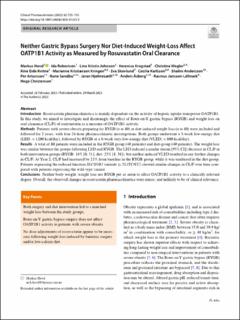| dc.contributor.author | Hovd, Markus Herberg | |
| dc.contributor.author | Robertsen, Ida | |
| dc.contributor.author | Johnson, Line Kristin | |
| dc.contributor.author | Krogstad, Veronica | |
| dc.contributor.author | Wegler, Christine | |
| dc.contributor.author | Kvitne, Kine Eide | |
| dc.contributor.author | Kringen, Marianne K. | |
| dc.contributor.author | Skovlund, Eva | |
| dc.contributor.author | Karlsson, Cecilia | |
| dc.contributor.author | Andersson, Shalini | |
| dc.contributor.author | Artursson, Per | |
| dc.contributor.author | Sandbu, Rune | |
| dc.contributor.author | Hjelmesæth, Jøran Sture | |
| dc.contributor.author | Åsberg, Anders | |
| dc.contributor.author | Jansson-Löfmark, Rasmus | |
| dc.contributor.author | Christensen, Hege | |
| dc.date.accessioned | 2023-07-31T10:56:59Z | |
| dc.date.available | 2023-07-31T10:56:59Z | |
| dc.date.created | 2023-04-12T12:42:20Z | |
| dc.date.issued | 2023 | |
| dc.identifier.citation | Clinical Pharmacokinetics. 2023, 62 (5), 725-735. | en_US |
| dc.identifier.issn | 0312-5963 | |
| dc.identifier.uri | https://hdl.handle.net/11250/3081936 | |
| dc.description.abstract | Introduction Rosuvastatin pharmacokinetics is mainly dependent on the activity of hepatic uptake transporter OATP1B1. In this study, we aimed to investigate and disentangle the effect of Roux-en-Y gastric bypass (RYGB) and weight loss on oral clearance (CL/F) of rosuvastatin as a measure of OATP1B1-activity.
Methods Patients with severe obesity preparing for RYGB (n = 40) or diet-induced weight loss (n = 40) were included and followed for 2 years, with four 24-hour pharmacokinetic investigations. Both groups underwent a 3-week low-energy diet (LED; < 1200 kcal/day), followed by RYGB or a 6-week very-low-energy diet (VLED; < 800 kcal/day).
Results A total of 80 patients were included in the RYGB group (40 patients) and diet-group (40 patients). The weight loss was similar between the groups following LED and RYGB. The LED induced a similar (mean [95% CI]) decrease in CL/F in both intervention groups (RYGB: 16% [0, 31], diet: 23% [8, 38]), but neither induced VLED resulted in any further changes in CL/F. At Year 2, CL/F had increased by 21% from baseline in the RYGB group, while it was unaltered in the diet group.
Patients expressing the reduced function SLCO1B1 variants (c.521TC/CC) showed similar changes in CL/F over time compared with patients expressing the wild-type variant.
Conclusions Neither body weight, weight loss nor RYGB per se seem to affect OATP1B1 activity to a clinically relevant degree. Overall, the observed changes in rosuvastatin pharmacokinetics were minor, and unlikely to be of clinical relevance. | en_US |
| dc.language.iso | eng | en_US |
| dc.rights | Navngivelse-Ikkekommersiell 4.0 Internasjonal | * |
| dc.rights.uri | http://creativecommons.org/licenses/by-nc/4.0/deed.no | * |
| dc.title | Neither Gastric Bypass Surgery Nor Diet-Induced Weight-Loss Affect OATP1B1 Activity as Measured by Rosuvastatin Oral Clearance | en_US |
| dc.type | Journal article | en_US |
| dc.type | Peer reviewed | en_US |
| dc.description.version | publishedVersion | en_US |
| cristin.ispublished | true | |
| cristin.fulltext | original | |
| cristin.qualitycode | 2 | |
| dc.identifier.doi | 10.1007/s40262-023-01235-5 | |
| dc.identifier.cristin | 2140274 | |
| dc.source.journal | Clinical Pharmacokinetics | en_US |
| dc.source.volume | 62 | en_US |
| dc.source.issue | 5 | en_US |
| dc.source.pagenumber | 725-735 | en_US |

